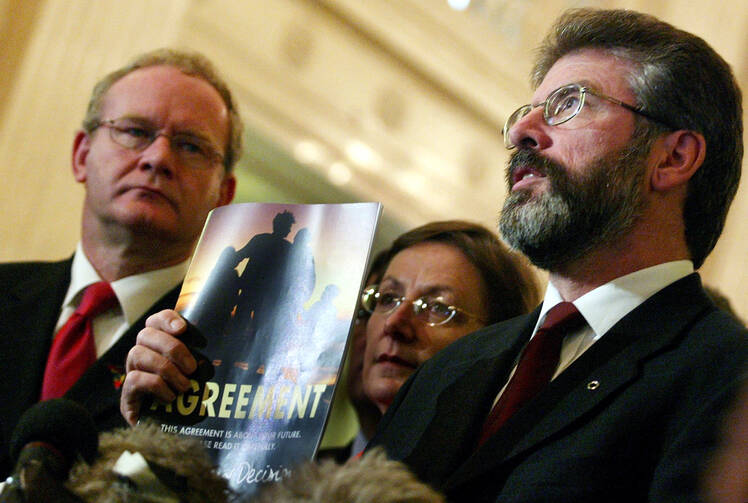(THE CONVERSATION) In 1988, one of Northern Ireland’s most divisive Protestant politicians rose to his feet and shouted at Pope John Paul II, who was addressing the European Parliament, “I denounce you as the Antichrist!”
Perhaps nothing could have more vividly symbolized the bitterness and hopelessness of the Northern Ireland conflict. A few years later, as I began my academic career studying British and Irish history, possibilities for ending the violent conflict between Protestant and Catholic communities in Northern Ireland seemed remote.
One decade later, on April 10, 1998, the Irish and British governments and the major political parties in Northern Ireland signed a breakthrough accord. Known as the Good Friday Agreement, or the Belfast Agreement, it set forth a framework for sharing power among the opposing political parties in Northern Ireland. Two years of grueling negotiations, chaired by former U.S. Sen. George Mitchell, appeared to put an end to a violent 30-year period known as “The Troubles.”
As the agreement turns 20, however, the future of Northern Ireland remains unclear. Several decades of certain violence, in which 3,500 were killed, have been replaced by an uncertain peace.
Northern Ireland’s government has collapsed, leaving governing power to the British Parliament at Westminster. Meanwhile, Britain’s pending departure from the European Union – known as Brexit – threatens to re-establish a formal border between Northern Ireland and its neighbor to the south, the Republic of Ireland. This could hamper the economic interactions and symbolic partnership that open borders have provided.
From partition to Troubles
The island of Ireland, situated off the west coast of the larger island of Great Britain, came under direct British rule in 1800. At that time, the Irish Parliament was dissolved and a newly formed United Kingdom of Great Britain and Ireland governed from England.
Politics in the 19th century were unsettled, however. Ireland’s indigenous, mostly Catholic population had few political and civil rights compared to Protestant elites, many of whom were British or of British descent.
Irish nationalists of varying stripes, who opposed British rule and Protestant domination, formed political movements aimed at obtaining independence from Britain in the 19th and early 20th centuries. By 1919, an Irish war for independence was underway.
By the end of the war in 1921, nationalists had won at least a partial victory: An Irish Free State was created with 26 counties – the forerunner of the current Republic of Ireland.
However, six of the most heavily Protestant counties in the northeast of Ireland remained a part of the United Kingdom. These counties are what are known as Northern Ireland, geographically part of the island, but politically still united with Britain after the war.
As the agreement turns 20, however, the future of Northern Ireland remains unclear.
The island was divided, and crucially, so was the society within Northern Ireland. Unionists or loyalists – those who wish to remain a part of the U.K. – are mostly Protestant and tend to identify as British. Nationalists or republicans, those who wish to see a fully united Ireland independent of British rule, are mostly Catholics who identify as Irish. Northern Ireland became divided between a Protestant and unionist majority, and a significant Catholic and nationalist minority.
“The Troubles” began in the late 1960s. A Catholic civil rights campaign sought to end discrimination by the Protestant-dominated government and police forces in Northern Ireland. Clashes between police and protesters led to charges of police brutality and eventually to further violence between the two communities.
Escalating violence led to the deployment of British troops, making many Catholics feel further alienated as the conflict worsened. Over the next 30 years, the people of Northern Ireland suffered through a sporadic but persistent war waged by nationalist and unionist paramilitary forces – armed groups that carried out assassinations, bombings and intimidation.
Given the prevalence of violence and seemingly irreconcilable political goals of unionists and nationalists, the Good Friday Agreement of 1998 was a major diplomatic achievement. The willingness of formerly sworn enemies to engage in negotiations paid major dividends: in 1972, the deadliest year of the Troubles, 479 people were killed.
In the 10 years following the Agreement, an average of eight people died per year in the conflict. In 2008, there were none.
Uncertainty: Brexit and beyond
The agreement’s 20th anniversary comes amid major questions about the future. Northern Ireland’s government has operated intermittently, and is currently suspended. Divisions between nationalists and unionists have been exacerbated by sharp differences over the U.K.‘s decision to leave the EU.
The decision has created questions about the border between Northern Ireland, which is part of the U.K., and the Republic of Ireland, an enthusiastic member of the EU. Because Northern Ireland is part of the U.K., it will leave the EU too.
Border negotiations are underway, but many people living near the border fear that restoring it could undermine years of progress.
The nature of the Brexit vote also seems reason for some concern. Religious identity proved to be a stronger predictor of Brexit votes in Northern Ireland than class: 85 percent of Catholics voted to remain, compared to only 40 percent of Protestants. A majority of working-class English and Northern Irish Protestant voters chose leave, while a majority of working-class Northern Irish Catholics voted to remain.
The U.K.’s departure from the European Union appears to give Catholics and nationalists renewed incentive to favor unification with the Republic, rather than working toward a functional, regionally self-governing Northern Ireland within the United Kingdom.
At the same time, there are reasons to be optimistic. The Good Friday Agreement brought an impressive measure of peace to Northern Ireland and offered a democratic future. But on this anniversary, as the agreement on peace remains tenuous, I believe Northern Ireland’s present and future both deserve attention from politicians in Westminster and Dublin.
This article was originally published on The Conversation. Read the original article here: http://theconversation.com/from-certain-war-to-uncertain-peace-northern-irelands-good-friday-agreement-turns-20-94624.










